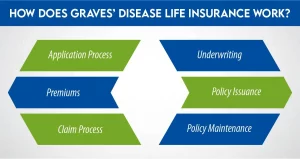In today’s world, getting life insurance can be a crucial step in securing your family’s financial future. However, for individuals diagnosed with Graves’ disease, navigating the various options of life insurance can present challenges. Graves’ disease is a health condition that might seem like a barrier to securing that protection for you and your loved ones. But don’t worry, we will simplify this process by offering some straightforward insights and practical solutions for you. In this blog post, we’ll explore Graves’ disease life insurance, uncovering its impact on insurance policies, and discovering the viable routes available for those seeking coverage despite this health challenge. Let’s explore this article together where health meets financial security, where clarity replaces confusion, and where informed decisions reign.
Please note that these figures are approximate estimates and can vary significantly based on individual circumstances and insurer-specific underwriting criteria. The premiums can vary widely based on individual health profiles and the specific underwriting decisions of insurance companies.
What is Graves’ Disease?
Graves’ disease is an autoimmune disorder characterized by the overproduction of thyroid hormones, leading to a condition known as hyperthyroidism. Named after Robert Graves, the physician who first described it, this condition primarily affects the thyroid gland, a butterfly-shaped organ located in the neck. The immune system, responsible for defending the body against infections, mistakenly attacks the thyroid gland, causing it to become overactive. This results in the excessive production of thyroid hormones, notably thyroxine (T4) and triiodothyronine (T3). These hormones play a vital role in regulating various body functions, including metabolism, heart rate, and temperature. Individuals with Graves’ disease often experience symptoms such as weight loss despite increased appetite, rapid or irregular heartbeat, anxiety, irritability, fatigue, tremors, and heat sensitivity. The condition can manifest differently in each individual, and its severity varies.Is Graves’ Disease a Critical Illness?
Graves’ disease, in itself, is not typically categorized as a critical illness in the same way as conditions like heart attack, stroke, cancer, or organ failure. Critical illness policies often include a specific list of severe conditions that trigger payouts upon diagnosis. However, the impact of Graves’ disease on an individual’s health can be significant if left untreated or poorly managed. The long-term effects of hyperthyroidism resulting from Graves’ disease can lead to complications affecting various body systems, such as the heart, bones, eyes, and mental health. The complications associated with Graves’ disease, such as heart problems (like atrial fibrillation), eye issues (Graves’ ophthalmopathy), osteoporosis, and psychiatric symptoms, can be severe and life-altering. Although it might not be classified as a critical illness for insurance purposes, the condition’s effects can indeed be critical to an individual’s health and well-being.Does Life Insurance Pay Out for Graves’ Disease?
Yes, life insurance can pay out for individuals who have Graves’ disease, provided that the policy was active and in force when the insured person passes away, and the cause of death is not excluded by the terms of the policy. When applying for life insurance, individuals with Graves’ disease might encounter some variations in the underwriting process compared to those without pre-existing health conditions. Insurers typically assess the risk associated with Graves’ disease based on various factors such as the severity of the condition, treatment history, current health status, and adherence to medical management plans. It’s important to disclose any pre-existing health conditions, including Graves’ disease, truthfully and thoroughly during the application process. Failing to disclose relevant information can lead to complications with claims processing, potentially resulting in denial of the death benefit. The payout from a life insurance policy for someone with Graves’ disease should be equivalent to the policy’s coverage amount if the conditions of the policy are met and the cause of death is not excluded. However, it’s crucial to carefully review the terms and conditions of the insurance policy to understand any exclusions related to pre-existing conditions or specific circumstances.
How Does Graves’ Disease Life Insurance Work?
Graves’ disease life insurance operates similarly to standard life insurance policies but may involve a more detailed underwriting process due to the pre-existing health condition. Here’s an overview of how it generally works:1- Application Process
When applying for life insurance with Graves’ disease, you’ll go through the standard application process, which involves providing personal information, medical history, and details about your condition. Be prepared to disclose information about your diagnosis, treatments, medications, and any related health complications.2- Underwriting
Insurers assess the risk associated with Graves’ disease to determine the premiums and coverage. They evaluate factors such as the severity of the condition, treatment history, current health status, adherence to medication and management plans, and any potential complications. This assessment helps them determine the level of risk you pose as an insured individual.3- Premiums
Premiums for life insurance with Graves’ disease might be higher due to the perceived increased risk. The insurer sets the premiums based on the assessed risk level. Individuals with well-managed conditions or those who demonstrate good adherence to treatment plans may receive more favorable rates compared to those with severe or uncontrolled cases.4- Policy Issuance
If approved, the insurance company issues the policy with specific terms, coverage amount, and premium payments. It’s crucial to review the policy details carefully to understand any exclusions related to Graves’ disease or pre-existing conditions.5- Claim Process
In the event of the insured’s passing, the beneficiary or the policyholder’s estate can file a claim. If the policy conditions are met, such as active coverage and compliance with policy terms, the insurer pays out the death benefit to the beneficiary.6- Policy Maintenance
Keeping the policy active by paying premiums on time and updating the insurer about any changes in health or treatments is essential. Failure to disclose changes or lapses in premium payments might impact the validity of the policy or the claim process.Can I Get Graves’ Disease Life Insurance?
Yes, it is possible to obtain life insurance if you have Graves’ disease. However, securing life insurance with a pre-existing health condition like Graves’ disease might involve a more thorough underwriting process and could result in higher premiums due to the perceived increased risk. Insurance companies evaluate each applicant individually, considering various factors related to Graves’ disease, including the severity of the condition, treatment history, current health status, adherence to management plans, and any associated complications or risks. While some insurers may be more cautious about offering coverage to individuals with pre-existing conditions, many insurance companies specialize in providing coverage for individuals with health challenges like Graves’ disease. These specialized insurers often have underwriting guidelines specifically designed to assess and accommodate high-risk medical conditions.How Much is Graves’ Disease Life Insurance?
The cost of life insurance for individuals with Graves’ disease varies widely. Factors such as age, health condition, severity of Graves’ disease, treatment, and coverage amount influence the premiums. Expect higher premiums due to the perceived higher risk associated with the condition. However, here is an estimated table to show you how premiums might differ based on age and coverage amount for individuals with Graves’ disease.| Age | Coverage Amount ($) | Monthly Premium ($) | Annual Premium ($) |
| 30 | $100,000 | $30 | $360 |
| 30 | $250,000 | $50 | $600 |
| 40 | $100,000 | $40 | $480 |
| 40 | $250,000 | $70 | $840 |
| 50 | $100,000 | $70 | $840 |
Buying Life Insurance with Graves’ Disease
Buying Graves’ disease life insurance involves navigating a unique set of considerations due to the pre-existing health condition. Here’s a step-by-step guide to help you through the process:Assess Your Needs
Gather Health Information
Research Insurers
Consult an Experienced Agent/Broker
Disclose Health Information Truthfully
Understand Policy Options
Compare Quotes
Review Policy Terms
Keep the Policy Active
The Bottom Line
In conclusion, obtaining Graves’ disease life insurance is feasible, but can be potentially more challenging. Being transparent about your medical history and seeking guidance from professionals specializing in high-risk cases can help secure suitable coverage. While premiums might be higher, life insurance remains a valuable financial tool to safeguard your loved ones’ future, providing peace of mind despite health challenges. Remember, each case is unique, and exploring various insurance options is essential to find the best fit for your needs.
Joyce Espinoza, Expert Life Insurance Agent
Joyce Espinoza is a trusted life insurance agent at mLifeInsurance.com. She’s been in the insurance industry for over ten years, helping people, especially those with special health conditions to find the right coverage. At MLife Insurance, Joyce writes easy-to-understand articles that help readers make smart choices about life insurance. Previously, she worked directly with clients at Mlife Insurance, advising nearly 3,000 of them on life insurance options.

